It’s winter, it’s dry, and… it’s the season for slipping pegs. Or it’s summer and humid, and pegs are stuck. You try to start class, and you are regularly interrupted by peg problems. It is such a time-waster! So here’s a quick post to help you troubleshoot problems with violin, viola, and cello pegs, and how to prevent peg problems as much as possible.
Stuck Pegs
Ever have those times when a peg just won’t budge? When you use pegs regularly, you naturally adjust them in response to changing environmental conditions. When you don’t use them, they can expand with humidity and other factors and get stuck – really stuck!
So what to do if they are stuck?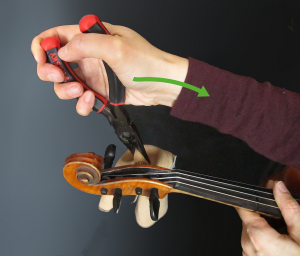
- Get a pair of pliers.
- Use a rag or some thick material to cover the peg head and protect it from being marred by the pliers.
- Hold the pliers PERPENDICULAR to the peg head and apply GENTLE pressure to loosen the peg.
- Always turn pegs towards you to loosen the string. It’s easier and it avoids accidentally breaking strings.
- Be sure to VERY GENTLY turn the peg. Let the leverage of the pliers do the work – it should be quite easy. Too quick and strong a force can break the peg, and then you will have new problems on your hand: how to get the end of the peg out of the peg box, and the expense of getting a new peg fitted!
Slipping Pegs
The pegs stay in place due to a combination of friction and the cooperating forces from properly fit pegs, proper string winding, and proper tuning technique. Go through and check for the following causes of slipping pegs:
- Are you pushing the peg into the pegbox as you tune? The pegs need friction to stay in place. Make sure you are pushing the pegs in firmly as you turn them.
- Dry weather is usually the culprit during winter. The pegs have shrunk and, at the same time, the hole has widened. After tuning a few times, the pegs should settle into the new conditions.
- Is the string wound neatly and in the right direction? How you wind your strings can have a huge impact on whether your pegs slip. With a properly wound string, the tension from the winding of the string helps keep the peg in the pegbox. A string wound in the wrong direction can actually make the peg want to pop out. See the previous post for how to wind a string properly.
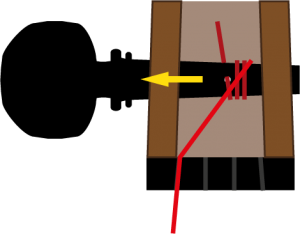
- Is there too much string wound between the hole and the peg box wall? This bunching can prevent the peg from
fitting further into the peg box.
- Check to see where the hole is in the peg. Is it too close to the pegbox? Is it starting to go into the pegbox wall? As a the wood of a new peg ages, shrinks, and gets deeper into the pegbox, the hole can end up too close to, or inside the peg box wall. This can prevent proper string winding, and prevent the peg from from fitting properly into the pegbox. If this is the case, you will need to have a new hole drilled.
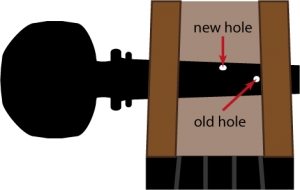
- Check for a properly fitting peg. As a last resort, take the peg out and examine the worn areas for evenness. The peg should have two nice shiny rings where it comes into contact with the pegbox wall. If the peg is not fitting properly, the shiny areas will not be even.
- Peg dope or no peg dope? You will find that peg dope is commonly recommended, but there are at least 80 instruments at my school and I have never had to use it. Although it can help, make sure it is not a band-aid solution for other problems. Also, if your pegs were working properly in the first place, stuck or slipping pegs are most often just a result of changes in humidity and lack of use. They just need time to adjust to the new conditions.
And the final tip for slipping pegs….
You know you are ready for March Break when….
I was changing a broken E-string when, mysteriously, every time it almost got to the right pitch, the peg would suddenly slip. I thought maybe I wrapped too much string against the peg box and that was pushing it out, so I rewound it. I thought maybe the hole was getting too close to the peg box, but that didn’t explain why it stayed in place until the last minute. It was so strange. I thought maybe somehow the peg didn’t fit anymore? No matter what I did, when the string was just about in tune, the peg would mysteriously pop out.
Then, on the what seemed like the tenth try, surprisingly, the string broke on me! What was going on?
It was when I went to get another string that I realized I was actually out of E-strings… I had grabbed an A-string by mistake and was trying to tune it to an E!
So last tip?
- Make sure you are using the correct string!
Note: My instrument repair and maintenance and experience come from my unique perspective as both a teacher, and from years of working with and learning from my late husband who was a talented luthier.


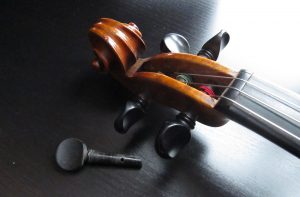
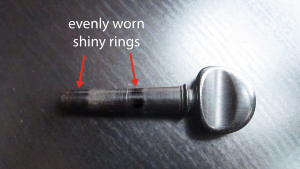
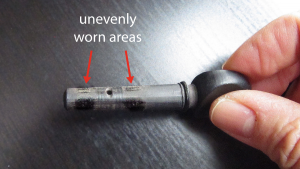
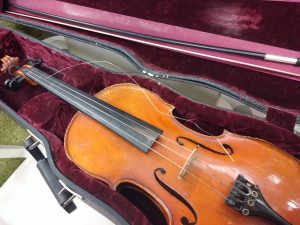

Leave a Reply